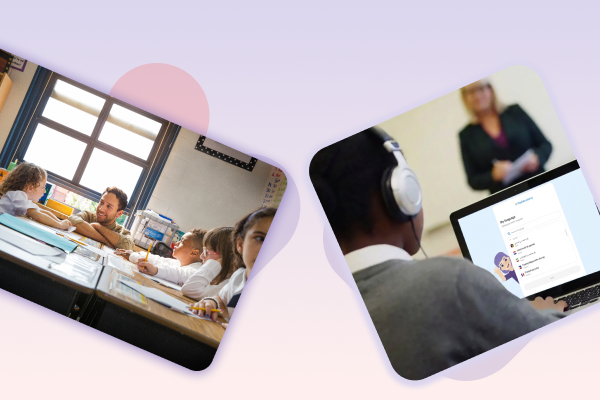

Right now, EAL is one of the fastest moving conversations for primary and secondary school teachers in the UK. EAL pupils now account for 20% of primary school children. With more and more EAL learners in the classroom up and down the country, speaking an ever-increasing number of different home languages, many staff feel daunted.
English as an additional language has been on the rise, something that all teachers have on their mind. The lack of resources available to them has made it harder for teachers, like yourself, to pick up ways to embed EAL learning techniques into the everyday classroom activities.
This learning roadblock, for many, is a real challenge to overcome.

Specific tasks for EAL pupils are very unique. They provide a method of learning for the students spanning various backgrounds and cultures to understand and provide the same learning experience as students native to the language, giving them all they need to succeed.
Schools in the UK, in particular, have become hosts to over 40+ languages and even more in some cases, per school, which has posed a real challenge for teachers
Over the last 10 years, due to a combination of migration and movement, schools have been taking in a lot more students that struggle with English and are fresh to the language and culture. Providing the same opportunities and activities is vital but leads to additional work for staff.
We’ve put together a few EAL activities to help onboard new students starting out with English.
These beginner level activities will help to engage them as they begin their new journey and provide them with a warm welcome to all of the students, in an effort to create a strong support network in the classroom.
5 EAL activities to try!
Interview with parents
(Only suitable for students of proficient English speaking parents.)
The interview with the parents of a non-English speaking student is always a great starting point. Understanding their current struggles, what languages they can speak, how they learn best, what existing learning they’ve been able to get involved in and how they work best with others will help to provide a strong outline of their character and opportunity when it comes to teaching them. Bringing your TA or additional staff members to this initial interview will provide a great all-around opportunity for staff to gather the best picture of how the child can be integrated into the classroom.
Within this meeting, outlining the rules, regulations and routines of the students in the classroom will be helpful. This will provide the parents with the “do’s” and “don’ts” in the school environment and also provide the student with less awkward moments than they might already have.This helps to curb the habits of the student in and around the school coming from their own language before it’s naturally lost in translation.
One of the struggles you might face is the parent’s linguistic abilities. This can be avoided if you or one of your staff can speak the native tongue and provide all the notes in English, so staff members across the board can access these and catch up on all that’s needed to make the student experience the best it can possibly be. Otherwise, a recommendation is to try the Community Days, which you can learn about below.

A Buddy System
On your student’s first few weeks at the school, they’ll encounter many other students in the classroom with varying levels of social interaction. Building relationships can be tough early on when language is a barrier. Taking control of this early and allowing a support network in the classroom to thrive, will help to smooth things out as they get into the flow of the routine.
Assigning your new student with a buddy can be a great way to kick things off. This buddy will accompany them around the school at all times, providing them with a helping hand, model behaviour to employ and a general support system when they find themselves in situations they aren’t quite sure about. Allocating a buddy will be a great resource and help alleviate the stresses of trying to integrate the students in activities outside of regular class time.
Introductory Welcome
A short explainer to a student’s background can sometimes give all pupils an opportunity to understand where a student is from and how they got here. By getting parental permission and of course, keeping things short and sweet, you’ll be able to provide the students with the country of origin, the story behind their move, their struggles and plans for the future. This just might give everyone the right insight to empathise with them.
This can help to curb any bullying, provide students with the right insights into culture and give them a wider perspective of who’s their new classroom student.

Community Days
If your selection of students have parents who are not yet proficient in English, trying a community day might be more effective as an introductory activity.
Community days are targeted towards encouraging community spirit and avoiding the focus on isolation. Bringing in everyone for a coffee and cake event after school can be a great way to get parents and children from non-English speaking backgrounds to communicate with staff, learn more about each other and help to avoid any stigmas. During these sessions, putting on English practice activities could be a great way to activate learning for the children and the adults trying to boost their skills.
Implementing Visual Supports
Having a host of visual supports existing in and around the classroom can be a lifesaver for staff and students alike trying to communicate a message. Using English flashcards or picture cards will be a great starting point until you can formulate your own resources within the classroom or to when the students are able to communicate outside of their native language.
Simple resources will help build a good skeleton and save time in learning scenarios. Even in one-to-one lessons, between staff and student, where the staff isn’t able to speak the native language of the student.

Hopefully, this starting set of activities will provide you with the ability to get the ball rolling with your new non-English speaking students. Creating an effective framework as they begin their journey in your classroom is vital. All of their learning journeys will be doubled in intensity, as they look to acquire English along the way, but with a focus on achieving with them and stressing their success will help to drive them forward.
Want more suggestions? Read our Easy EAL Games to Try with Pupils blog.
Is your school seeking new and effective strategies to tackle the EAL challenge? Find answers at EAL Birmingham 2018!
iCentrum, Birmingham Science Park
10th May 2018, 9:00am-13:30pm
UPDATE: This is a past event and is not active.

